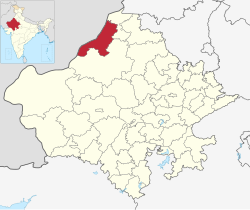Demographics
Population
According to 2011 census of India, the total population of what was now Anupgarh district was 698,478. 114919 (16.45%) lived in urban areas. Anupgarh district had a sex ratio of Scheduled Castes and Scheduled Tribes made up 307,944 (44.09%) and 3,760 (0.60%) of the population respectively. [9] [10]
Total population, total families and Population density of tehsils according to 2011 census. [11] [12] [13] [14] | Tehsil | Population | Total families | Population Density people/km2 |
|---|
| Raisinghnagar | 196,455 | 37,854 | 148/km2 |
| Anupgarh | 1,84,423 | 36,488 | 159/km2 |
| Gharsana (including Rawla Mandi) | 1,71,830 | 34,350 | 124/km2 |
| Sri Vijaynagar | 1,45,770 | 28,721 | 172/km2 |
| Total/Average of Anupgarh District | 6,98,478 | 1,37,413 | 150.75/km2 |
|---|
Religion
Religious profile of tehsils according to 2011 census.| Tehsil | Hindu | Sikh | Muslim | Jain | Buddhist | Christians | Not stated | Others |
|---|
| Raisinghnagar [11] | 1,35,965 | 58,857 | 1,118 | 158 | 110 | 161 | 48 | 38 |
| Anupgarh [12] | 1,25,624 | 56,119 | 2,394 | 6 | 34 | 145 | 94 | 7 |
| Gharsana (including Rawla Mandi) [13] | 1,22,440 | 40,412 | 8,620 | 130 | 51 | 96 | 52 | 29 |
| Sri Vijaynagar [14] | 1,11,089 | 32,468 | 1,700 | 20 | 156 | 268 | 67 | 2 |
| Total of Anupgarh District | 4,95,118 | 1,87,856 | 13,832 | 314 | 463 | 558 | 261 | 76 |
|---|
| Religions in Anupgarh District (2011) |
|---|
| Religion | | Percent |
| Hinduism | | 70.89% |
| Sikhism | | 26.90% |
| Islam | | 1.98% |
| Other or not stated | | 0.23% |
Census 2011 shows that there were 4,95,118 Hindus and 1,87,856 Sikhs in the district with Muslims being third largest community in the district with around 13,832 individuals. [16]
Literacy rate
Average literacy rate and Sex ratio in Anupgarh district is 64.25 % and 898.5/1000 respectively.
According to census 2011, with 69.91% literacy, and a ratio of 908 females to 1000 males. Raisinghnagar is the most literate tehsil in Anupgarh district with hights sex ratio with 69.33% of male literates and 52.23% of female literates living in the tehsil. On the other hand, Gharsana shows the lowest literacy rate of 65.76% with 65.54% of males and 47.28% of females literate in the tehsil. Gharsana tehsil had a sex ratio of 892 females/1000 males in year 2011 which was least among all tehsils of Anupgarh District and Raisinghnagar had highest sex ratio of 902 females/1000 males.
Total literally rate and sex ratio among tehsils and Anupgarh district according to 2011 census.| Tehsil | Total literacy rate | Male literacy | Female literacy | Sex Ratio females/1000 males |
|---|
| Raisinghnagar [11] | 69.91% | 69.33% | 52.23% | 908 |
| Anupgarh [12] | 66.34% | 65.39% | 48.57% | 900 |
| Gharsana (including Rawla Mandi) [13] | 65.76% | 65.54% | 47.28% | 892 |
| Sri Vijaynagar [14] | 66.68% | 64.55% | 48.98 | 894 |
| Literacy rate and Sex ratio in district | 64.25 % | 63.45 % | 45.72 % | 899 |
|---|
Recent Updates
On 28 December 2024, the Cabinet of Rajasthan decided not to retain 9 new districts- Anupgarh, Dudu, Gangapur City, Jaipur Rural, Jodhpur Rural, Kekri, Neem Ka Thana, Sanchore, and Sanchore, and Shahpura- along with the 3 newly created divisions--Banswara, Pali, and Sikar. [17] [18]
This page is based on this
Wikipedia article Text is available under the
CC BY-SA 4.0 license; additional terms may apply.
Images, videos and audio are available under their respective licenses.








